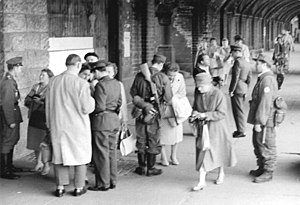Oberbaum Bridge
You can helpexpand this article with text translated fromthe corresponding articlein German.(June 2017)Click [show] for important translation instructions.
|
This articleneeds additional citations forverification.(June 2021) |


TheOberbaum Bridge(German:Oberbaumbrücke) is a double-deck bridge crossingBerlin,Germany'sRiver Spree,considered one of the city'slandmarks.It linksFriedrichshainandKreuzberg,formerboroughsthat were divided by theBerlin Wall,and has become an important symbol of Berlin's unity.[1]
The lower deck of the bridge carries a roadway, which connectsOberbaum Straßeto the south of the river withWarschauer Straßeto the north. The upper deck of the bridge carriesBerlin U-Bahn linesU1andU3,betweenSchlesisches TorandWarschauer Straßestations.
The bridge appears prominently in the filmsRun Lola RunandUnknownas well as the TV seriesBerlin Station.
History
[edit]

The bridge is built on the former boundary of the municipal area with its rural environs, where anexcise wallwas built in 1732. A wooden drawbridge was built as part of the wall; it served as a gate to the city. The nameOberbaumbrückestemmed from the heavy tree trunk, covered in metal spikes, that was used as aboomto block the river at night to prevent smuggling. (Baummeans tree in German, but can also mean boom as in this case; thus the name means something like "Upper [Upstream] Boom Bridge"; there was another tree-trunk barrier at the western end of the contemporary city limits, close to today's Unterbaumstraße (lit. in English:Lower [Downstream] Boom Street.)
By 1879 the wooden bridge had been modified greatly. At 154 meters it was Berlin's longest, but was no longer adequate to the amount of traffic crossing it. Plans began to be drawn up for a new stone construction. TheSiemens & Halskecompany, which was planning to build theBerlin U-Bahn(subway), insisted on a combined crossing for road vehicles, pedestrians, and the new rail line.
The new bridge opened in 1896 after two years of construction, in time for theBerlin Trades Exhibition.[2]The architect and government officialOtto Stahn(1859–1930) designed it in the North GermanBrick Gothicstyle of a city gate with many decorative elements, such as pointed arches, cross vaults, and coats of arms. The two towers were inspired by the Middle Gate Tower (Mitteltorturm) in the northernBrandenburgcity ofPrenzlau.Although purely cosmetic, they served as a reminder that the site was once Berlin's river gateway.
In 1902 the first segment of the U-Bahn opened. Its inaugural journey, carrying 19 passengers, ran fromStralauer Tor,at the eastern end of the bridge, toPotsdamer Platz.Stralauer Tor was dismantled after being damaged in a 1945 air raid, but its four sandstone-clad support posts can still be seen.
After Berlin absorbed several other municipalities in 1920, the Oberbaum Bridge became the crossing between the new boroughs ofFriedrichshainandKreuzberg.In April 1945 theWehrmachtblew up the middle section of the bridge in an attempt to stop theRed Armyfrom crossing it. After the war ended, Berlin was divided into four sectors. The Oberbaum Bridge crossed between the American andSoviet sectors.Until the mid-1950s, pedestrians, motor vehicles, and the citytramwaycould cross the bridge without difficulty.
Border crossing
[edit]

When the Berlin Wall was built in 1961 the bridge became part ofEast Berlin's border withWest Berlin;as all the waters of theRiver Spreewere within the Friedrichshain limits, theEast Germanfortifications extended up to the shoreline on the Kreuzberg side. As a result, the WestBerlin U-Bahnline was forced to terminate atSchlesisches Tor.Beginning on 21 December 1963, the Oberbaum Bridge was used as a pedestrian border crossing for West Berlin residents only.
Three brief openings of the bridge occurred by the summer of 1966. A permanent opening for pedestrians came with the 1972 Four Power Agreement for Berlin. A building for the East Berlin control authorities was built directly on the eastern bank of the Spree, across the street from theOberbaumbrücke.The part of the subway viaduct crossing the Stralauer Allee at the bridge was completely demolished. The towers were demolished in the 1970s. Since the border on the Kreuzberg shore (Gröbenufer) ran along the Spree, several children from Kreuzberg drowned on the Oberbaum bridge because rescue personnel from west side could not reach them, and this was prohibited from the east side. Responding to this an agreement on rescue operations if accidents in Berlin's border waters was signed on October 29, 1975. In 1976, an emergency call column was installed on the southern bridgehead, after whose activation drowning help was provided.
The coat of arms of the district Friedrichshain–Kreuzberg with theOberbaumbrücke The Oberbaum Bridge, which formed part of the Friedrichshain coat of arms since 1991, was also included in the coat of arms of the new Berlin district of Friedrichshain–Kreuzberg after the district merger.
Post-Berlin Wall
[edit]
After the removal of theBerlin Wallin 1989, andGerman reunificationthe following year, the bridge was rebuilt and restored to the former appearance, albeit with a new steel middle section designed by the Spanish architectSantiago Calatrava.Reconstruction began in January 1992, with the war-damaged parts of the bridge rebuilt. It opened to pedestrians and traffic on 9 November 1994, the fifth anniversary of the opening of the Berlin Wall. The U-Bahn line toWarschauer Straße stationwas reopened a year later.
Since 1997, aneoninstallationentitled "Stone – Paper – Scissors" byThorsten Goldberghas adorned the bridge. Its two elements are engaged in a constant game ofrock, paper, scissors,suggesting the arbitrariness of immigration decisions, both during theCold Warand for today'sasylum seekersandpoverty migrants.
Since the creation of the unifiedFriedrichshain-Kreuzbergborough in 2001, the Oberbaum Bridge no longer crosses a jurisdictional boundary.
In April 2019 the Oberbaum Bridge was blockaded as part of an international series of protests organised byExtinction Rebellion.[3]
The bridge was used as the location for the defection of Karla to George Smiley and British intelligence in the book and mini series, Smiley's People.
See also
[edit] Media related toBridges in Berlinat Wikimedia Commons
Media related toBridges in Berlinat Wikimedia Commons- List of bridges in Germany
- List of road-rail bridges
References
[edit]- ^"Europe's most beautiful bridges".Deutsche Welle.8 April 2019.Retrieved29 September2020.
- ^Martin, Guy (31 August 2015)."Berlin's Waterfront Heats Up for Travelers".Wall Street Journal.ISSN0099-9660.Retrieved29 September2020.
- ^Leister, Annika (15 April 2019)."Extinction Rebellion: Klima-Aktivisten legten mit Sitzblockade die Oberbaumbrücke lahm".Berliner Zeitung(in German). Berliner Zeitung.Retrieved17 April2019.


